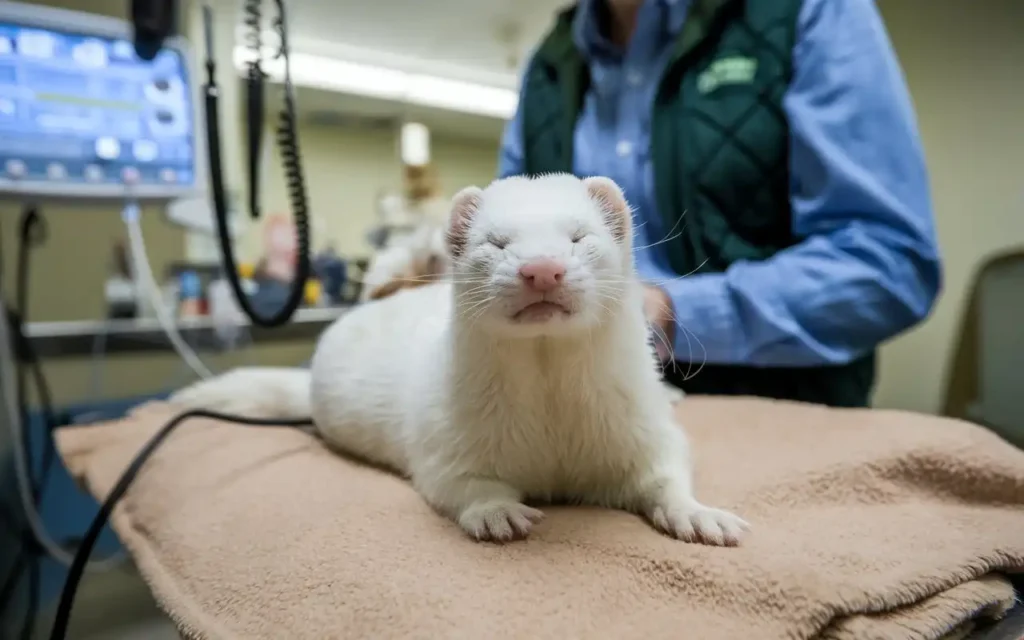Canine distemper in ferrets is a serious viral illness. It poses major risks to their health and well-being. This highly contagious disease can be fatal if not treated. It often spreads from dogs to ferrets. Ferret owners must know the early signs of this disease. They must also know how to prevent and manage it. This article will explore canine distemper in ferrets. We’ll cover symptoms, prevention, and care tips to keep your pets safe.
Table of Contents
What is Canine Distemper in Ferrets?
Canine Distemper is a viral infection. It is caused by the Canine Distemper Virus (CDV), which is in the Paramyxoviridae family. It mainly affects dogs. But ferrets are highly susceptible due to their similar respiratory systems. The virus spreads quickly through airborne droplets or direct contact with infected animals. It can survive in the environment for a short time. So even indirect exposure can cause infection. This includes contact with contaminated surfaces, water bowls, or bedding. Once inside, the virus targets the immune, respiratory, and central nervous systems. This causes a range of symptoms. The disease progresses quickly. Without early intervention, it is hard to manage. So, we must understand how the virus affects ferrets.
How Ferrets Contract Canine Distemper
Ferrets can catch canine distemper, usually by direct contact with infected dogs. The virus can be transmitted through saliva, urine, or feces of an infected animal. Ferrets are at high risk if kept with unvaccinated dogs or exposed to wild animals. It can also spread through respiratory droplets from an infected animal’s sneeze or cough. This poses a risk even without direct contact. Ferrets can also be exposed through contaminated objects. These include food dishes, blankets, and toys that have touched an infected animal. Being vigilant about potential exposure sources is key to preventing infection.

Symptoms of Canine Distemper in Ferrets
Recognizing the symptoms of canine distemper in ferrets is essential for early intervention. The disease may start with mild symptoms. They can be mistaken for other illnesses. So, ferret owners must know all possible signs.
Early Signs to Look Out For
The early symptoms of canine distemper in ferrets often mimic those of a common cold. These include mild fever, sneezing, runny nose, and a slight discharge from the eyes. Ferrets may seem less active and eat less. This is often a first warning sign. A sudden change in behavior can indicate the virus. Hiding more than usual or being unusually tired are signs. While these signs may seem minor, they should not be ignored, as the virus can progress rapidly.
Severe Symptoms and Complications
As canine distemper advances, symptoms become more severe. Ferrets may get high fevers, a runny nose, and labored breathing due to lung inflammation. Neurological symptoms can also appear, including tremors, seizures, and paralysis. These symptoms suggest the virus has harmed the central nervous system. This often indicates a severe infection. Hyperkeratosis, or thickening of the footpads, indicates a severe case. It is sometimes called “hard pad disease.” Once advanced symptoms appear, the prognosis worsens. This highlights the need for early detection and treatment.



How Canine Distemper in Ferrets Spreads
Understanding how canine distemper spreads is critical for preventing its transmission. The virus spreads quickly in places with many close animals, like multi-pet homes, pet stores, and boarding facilities.
Transmission from Dogs to Ferrets
Dogs are the primary carriers of the Canine Distemper virus, making unvaccinated or infected dogs a major risk for ferrets. Even brief exposure to a dog shedding the virus can be enough to transmit the infection. Pet owners should be extra cautious during local distemper outbreaks. Visiting dog parks or allowing ferrets to roam where infected dogs may have been can be a significant risk. To protect ferrets, vaccinate any dogs in the household.
Airborne and Contact Transmission
Canine distemper can spread through airborne transmission, as well as contact with infected dogs. When an infected dog or ferret coughs or sneezes, the virus can linger in the air. Nearby animals may inhale it. It can also spread through contaminated surfaces like water bowls, toys, or bedding. It’s crucial to clean and disinfect your ferret’s space regularly. Do this, especially if they might have been exposed to an infected animal.
Impact of Canine Distemper on Ferrets’ Health
Canine distemper can severely harm a ferret’s health. It affects multiple organ systems. Without prompt treatment, the virus can cause long-term complications that may be life threatening.
Respiratory Complications
One of the primary systems affected by canine distemper in ferrets is the respiratory system. Symptoms like coughing, wheezing, and a runny nose can lead to severe pneumonia. It can make it hard for the ferret to breathe. Respiratory distress can become so severe it needs urgent vet care, like oxygen therapy. Sometimes, even with aggressive treatment, the lungs can be permanently damaged. This can leave the ferret with chronic breathing problems.
Neurological Symptoms
Neurological symptoms occur when the distemper virus reaches the brain. As the virus progresses, ferrets may have muscle spasms, a head tilt, and full-body seizures. Often, these symptoms are irreversible, even with supportive care. Neurological damage often means a more advanced stage of the disease. The chance of recovery then diminishes. Early vet care is vital. It prevents severe outcomes and manages symptoms.

Diagnosing Canine Distemper in Ferrets
An accurate diagnosis is the cornerstone of effective treatment for canine distemper in ferrets. A misdiagnosis or delay in diagnosis can quickly harm a ferret’s health. So, it’s vital to get veterinary care at the first sign of illness.
Veterinary Testing Methods
Veterinarians use physical exams and tests to confirm canine distemper in ferrets. Common tests include blood tests and PCR tests. Blood tests detect antibodies to the virus. PCR tests identify the viral RNA in samples. Additionally, chest X-rays may be conducted to assess the extent of respiratory involvement. Swab samples from the nose or eyes may also be used to detect the presence of the virus. These tests show how far the disease has progressed. They guide treatment.
Importance of Accurate Diagnosis
An accurate diagnosis ensures the ferret gets the right treatments. This avoids unnecessary meds or procedures that could cause more stress. Misdiagnosing distemper as another illness could delay vital care. This would reduce the ferret’s chance of survival. A thorough diagnosis lets vets warn pet owners of risks to other animals in the household. This helps prevent further spread.
Prevention of Canine Distemper in Ferrets
Prevention is always more effective than treatment when it comes to canine distemper in ferrets. Proactive measures can greatly reduce the risk of ferrets contracting a deadly virus.
Vaccination as a Key Measure
Vaccination remains the most reliable method of preventing canine distemper in ferrets. A vaccine helps the immune system fight the virus. It reduces the chance of severe infection. Keep ferrets on a strict vaccination schedule, as vets recommend. Even indoor ferrets should be vaccinated. The virus can be brought in on other animals or clothing.
Isolation from Infected Animals
Isolating ferrets from animals that may be infected with canine distemper is crucial. If a dog in the household is diagnosed with distemper, immediately separate the ferret to prevent any chance of exposure. Avoid areas where infected animals may have been, like dog parks or boarding facilities, during an outbreak. Keep ferrets away from them. Careful management of the environment can greatly reduce the risk of transmission.
Treatment Options for Canine Distemper in Ferrets
There is no cure for canine distemper in ferrets. But prompt, supportive treatment can help. It may ease symptoms and improve recovery chances. The treatment aims to manage symptoms, prevent infections, and comfort the ferret during recovery.
Antiviral Medications and Supportive Care
Canine distemper is a viral infection. So, antiviral meds can sometimes be used to slow the virus’s replication. However, their effectiveness varies, and they are usually used alongside supportive care. Supportive care can include fluids to prevent dehydration. It can also include nutrition to maintain weight and strength. It can also include antibiotics to prevent pneumonia. Doctors may prescribe pain relievers. They can ease pain from nerve issues or breathing problems. A cozy, stress-free environment is vital for the ferret’s comfort. Stress can weaken their immune system.
Long-Term Care for Infected Ferrets
Ferrets that survive the acute phase of Canine Distemper often require long-term care due to residual symptoms. This can include ongoing meds for nerve issues, respiratory therapies, or home changes for physical limits. Regular vet check-ups are essential. They monitor progress and address complications. Ferret owners must commit to caring for a ferret recovering from distemper. Its needs may be more complex than those of a healthy ferret.

Recovery and Prognosis of Canine Distemper
The prognosis for ferrets with Canine Distemper depends on how early the disease is detected and treated. The sooner we identify the virus and provide care, the better the chance of recovery. However, the disease can be unforgiving, and the outcome may vary.
Factors Influencing Recovery
A ferret’s recovery from Canine Distemper can depend on several factors. These include age, health, and how quickly treatment began. Younger ferrets with strong immune systems may manage symptoms better. Older or weakened ferrets might struggle more with the virus. The type and severity of symptoms matter. Ferrets with mild respiratory issues may recover faster than those with severe neurological ones. Each ferret’s case is unique. So, it is key to work closely with a vet to adapt the care plan.
Potential Long-Term Effects
Even if a ferret survives Canine Distemper, they may face long-term health challenges. These can include chronic respiratory issues, like breathing problems and a risk of infections. Neurological damage can persist. It may cause tremors or coordination problems. These may require special accommodations in their living space. These long-term effects may impact a ferret’s quality of life. But, with care and attention, many can still live comfortably. Ferret owners must understand and accept the risks. It’s vital to support their pets during and after recovery.
Preventing Spread of Canine Distemper
If you own multiple pets, especially those prone to canine distemper, take extra precautions to prevent the virus’s spread. Implementing these measures can help protect all the animals in your care.
Isolating an Infected Ferret
Isolation is the first step in containing the virus within a household. If a ferret is diagnosed with canine distemper, separate it from other pets immediately. Choose a specific area in your home for the infected ferret to recover. Keep it away from the common spaces used by other animals. Use gloves and protective clothing when handling the sick ferret. This will prevent the spread of the virus to other pets. Regularly clean and disinfect the isolation area. Keep bedding, food bowls, and toys separate.
Routine Cleaning and Disinfection
Canine distemper can survive for a short time on surfaces. So, regular cleaning is essential to reduce transmission risk. Use pet-safe disinfectants to clean surfaces, floors, and any areas where your pets frequent. Wash items like blankets, toys, and food bowls with hot water. This will destroy any lingering virus particles. A cleaning routine can greatly reduce the risk of exposing other animals in the home to the virus. If you have visitors, let them know about the situation to prevent unintentional spread.
Quarantine’s Role in Averting Flow to Dogs and Cats
In homes with multiple pets, especially ferrets and dogs, quarantine is vital. It prevents cross-species infection. Dogs, being primary carriers, pose a significant risk to unvaccinated ferrets.
Separate Housing for Infected Animals
Quarantine means keeping infected animals in a separate room. It must have no shared ventilation or access to other pets. This helps prevent airborne transmission, which can occur through sneezing or coughing. During this period, limit contact with other pets. Wash your hands after interacting with the infected ferret. The quarantine should last until your vet confirms it is safe. This can vary depending on the severity of the case, so always follow your vet’s recommendations.
Safe Interaction Between Pets
After the quarantine, it’s vital to reintroduce animals slowly. This is to ensure there is no risk of remaining viral particles. Monitor all animals closely for any signs of illness during the first few weeks after reintegration. Supervise their interactions. If possible, keep each pet in a separate space until you are sure the risk of transmission is gone. This approach can help ensure the safety of all pets, providing peace of mind for pet owners.

Frequent Myths About Canine Distemper in Ferrets
Misconceptions about canine distemper in ferrets can lead to poor care and delayed treatment. Addressing these myths is important for better understanding and managing the disease.
Debunking Myths and Misinformation
A common myth is that only dogs need distemper vaccines. Ferrets can remain unvaccinated without risk. This belief is dangerous, as it ignores the fact that ferrets are highly vulnerable to the virus. Another misconception is that Canine Distemper is always fatal in ferrets. While it is a serious illness, early detection and proper care can significantly improve a ferret’s chances of recovery. Some believe that if a ferret survives distemper, it can’t be infected again. But surviving ferrets can be carriers and spread the virus.
Importance of Professional Advice
While online resources can be helpful, they should never replace professional veterinary care. Canine distemper in ferrets requires specialized knowledge for accurate diagnosis and treatment. Relying on home remedies or anecdotal advice can lead to worsened conditions and decreased chances of recovery. Always consult a vet for information on vaccines, treatments, and caring for your sick ferret. A professional can guide you through each step of managing this complex disease.
Role of Vet Care in Guiding Canine Distemper
Veterinary care is indispensable for managing canine distemper in ferrets. A knowledgeable vet can help you with treatment options. They will ensure your ferret receives the best care.
When to Visit the Vet
Timing is critical when dealing with canine distemper. If your ferret has a high fever, eye or nose discharge, or unusual behavior, see a vet ASAP. Early intervention can help. It can control the virus and relieve symptoms. Regular vet visits are needed to check your ferret’s health and vaccinations. This reduces the risk of distemper.
Importance of Follow-Up Checkups
After the initial treatment, follow-up checkups are crucial for monitoring the ferret’s recovery. These visits let the vet adjust medications, provide treatments, and address any complications. Follow-up care is vital for ferrets with neurological symptoms. They may need specialized therapies or ongoing support. Consistent veterinary care helps track your ferret’s recovery. It aids in making informed decisions about next steps.
Conclusion
Canine distemper in ferrets is a severe disease. It requires immediate action and prevention. Knowing the symptoms, vaccinating on time, and seeing a vet can greatly improve your ferret’s health. Stay informed. Take steps to protect your ferret. This can reduce the risks of a dangerous virus. Remember, a healthy and happy ferret is the result of informed care and vigilance.






